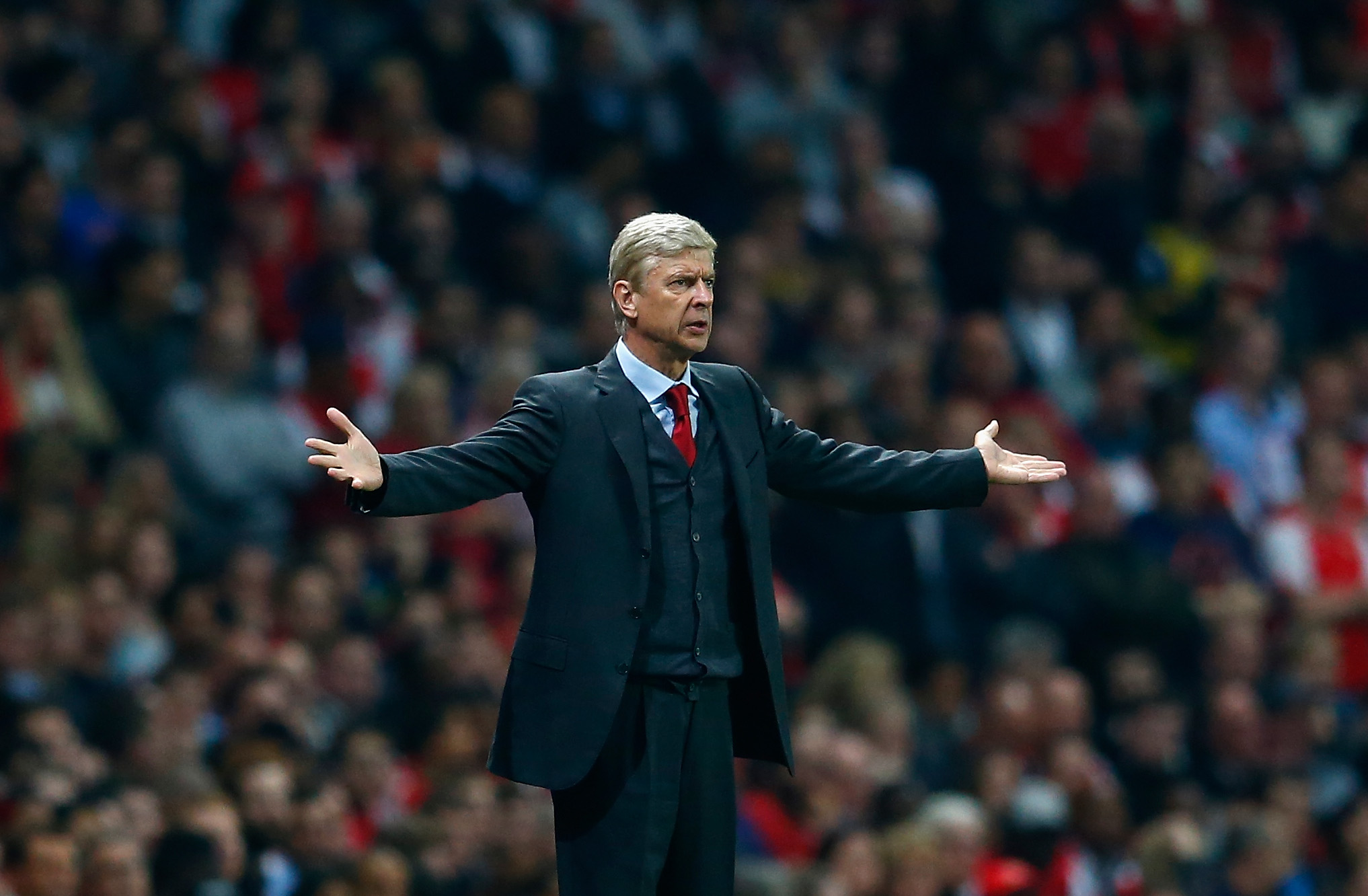Arsenal FC | In a league filled with tacticians, Wenger needs to adapt or become obsolete

There was a time when the tactical complexity and variations in English football ranged from hoofing the ball towards a big and burly striker to pinning the ball out wide to the wings. The formations varied from a wide 4-4-2 to a narrow 4-4-2, while a 4-1-2-1-2 diamond was deemed revolutionary. The English Premier League has come a long way from those days. The league now boasts of housing some of the most tactically brilliant minds in Europe. A three-man defense is not considered alien anymore, and we have also seen a rise in the number of small and diminutive, but explosive, strikers over the years.
However, amid all these changes, Arsene Wenger remains
But all these years later, it is the Frenchman who is standing at the receiving end of the 'wind', and he appears determined to stand his ground.
While one must praise the conviction and belief he has in his philosophy, and his dedication towards playing aesthetically pleasing football, Wenger needs to realize that there is more than one way of doing it. He has never been a tactically proactive manager. He would hardly step aside from his trusted system unless he is forced to. The only variance he has brought in over the years has been a move from a counter-attacking style of football to possession-based football. However, this current team is struggling to side on either of those two systems.
This team is not as effective on counter-attacks like the Thierry Henry-led attack of the early 2000s or even the Cesc Fabregas-led team from the 2007-08 season. There was a time when opposition teams used to fear their own corners because a lot of them usually converted into Arsenal goals. This team has struggled to create those fast and fluid transitions on the break, at least with any consistency.

 The 2007-08 Arsenal team was special! © Getty Images
The 2007-08 Arsenal team was special! © Getty ImagesOn the other hand, they even struggle to break down their opponents through the middle with possession-based football, especially when their opponents defend deep in their own halves. Arsenal now relies more on individual brilliance than ever.
Against Southampton and more recently against PSG, the Gunners produced a couple of uninspiring performances but got the desired results. A home win against the Saints and a draw away from home against the toughest side in the group are fairly decent results, but things could have been so much different had Shane Long and Edinson Cavani showed a bit more composure in front of the goal.
Currently seventh in the league table, Arsenal and Arsene Wenger need to iron out a few issues in the team before they can think about launching a sustainable title challenge. While the attackers are yet to get into their stride, it is the problems at the back which requires immediate attention at the moment.
Arsenal provided Long and Cavani with a total of six open chances to score in their last two games, and they certainly cannot rely on opponent strikers missing these chances in every game.
Arsene Wenger invested £35m in signing German international Shkodran Mustafi, and that is a lot of money for a defender, even in today's inflated market. However, more than the fee, it was the fact that Arsenal waited so late into the transfer window to sign him is the bigger concern. Mustafi's late arrival meant that he did not have the chance to have a proper preseason at the club, and it is showing in his performances.
The solidity of a defence depends heavily on the understanding and partnership of the two center backs, and if both the players are not confident of each other, it could prove to be catastrophic. Perhaps no other partnership on the pitch is so delicate.
The fact that both
A lot of the instability at the back is also due to the change in the role of Francis Coquelin. Last season, the Frenchman was a revelation. Arsenal finally had a proper defensive midfielder for the first time since Gilberto Silva had left the club. (PS – Alex Song was too tactically indisciplined and attack-minded to be called a proper defensive midfielder)
Almost refreshingly, Arsenal finally had someone who could just sit back and defend without giving into his adventurous streaks, and it worked wonders for the midfield. Coquelin dropped back to form a three-man defence when Arsenal had the possession of the ball. This allowed the two center backs to move out wide, and in turn, it allowed the fullbacks to push forward in attack. Hector Bellerin, in particular, benefited a great deal from this. It allowed him to bomb forward without concerning himself too much about living unguarded space behind him, and his pace and width added a different dynamic to the Arsenal attack.
However, things have changed this season.
Santi Cazorla's return to the side has been beneficial for the Gunners, and the Spaniard has been their most influential player so far this season. However, his impact has been partially due to the change in the role of Coquelin in the midfield.
Against Southampton, the Frenchman was seen operating in a more advanced role. Instead of dropping deep alongside the center back, he moved higher up the pitch when Arsenal had the ball. This opened up a lot of space between the defence and the midfield, and the two center backs were seen dictating a lot of the play from the back. Perhaps one of the reasons why Mustafi was brought in to the side was his ability with the ball at his feet, as opposed to his abilities without it. In the past, Koscielny, at times, would break from the defence to move the ball forward in attack. Now Wenger has two ball-playing center backs at his disposal.
Coquelin is acting as a decoy in the midfield to free up Cazorla, and it has helped the Spaniard to dictate the tempo of the match. However, this change in role for Coquelin has had three adverse effects. Firstly, when Arsenal lose the ball in attack, the defence is exposed very easily as Cazorla's defensive skills are limited. While Coquelin in an advanced role gives Arsenal the chance to win back the ball immediately in the final third, it also leaves them vulnerable at the back if their opponents manage to bypass him.
Secondly, the fullbacks, Bellerin in particular, have less freedom to move forward, and if they do so, they do it with the risk of leaving a lot of space behind them for the wide players to exploit. Finally, Coquelin is now operating in the same space which Ozil operates, or likes to operate from. This is also limiting the German's influence on the game.
For my latest column, looking at Coquelin's positioning v S'oton. "Decoy" role saw him mainly pop up in final third pic.twitter.com/VtSKfECtaE
— Arsenal Column (@ArsenalColumn) September 12, 2016
Wenger is sacrificing a lot to bring out the best of Cazorla when he has a much more viable option at his disposal—change the team's formation to 4-3-3. With the likes of Mohamed Elneny and Granit Xhaka on the bench, Wenger has the resources to shift to a 3-man midfield, which will not only allow Cazorla to operate more freely but will also protect the defence at the back. However, this is where Wenger's unwillingness to change tactics comes into play.
History can be harsh, and Arsene Wenger might go down as the man who changed English football, but could not change himself when the time came for him to do so.
Playing Mesut Ozil out wide, a role in which he has played previously at Real Madrid and for the German national team is a bit of risk. But, a 3-man midfield will allow the fullbacks to bomb forward, which in turn will allow Ozil the space to drift inside to a more central role. Moreover, Xhaka adds a lot of physicality to the midfield and provides an alternative to Cazorla in case the Spaniard is being marked out by the opponent. Against PSG, Wenger had the perfect chance to deploy this formation. In fact, it seemed a little baffling that Wenger trusted Cazorla and Coquelin to battle against a midfield that featured Marco Verratti, Grzegorz Krychowiak, and Adrien Rabiot, especially with someone like Ozil in the team, who hardly tracks back.
Arsene Wenger has strengthened the spine of the team in this transfer window, and he now possesses one of the best midfields in the league, in depth and in quality, at his disposal. It is now a matter of accepting that his old ways are out of fashion. It is in the midfield that matches are won and lost. For once, Wenger needs to be proactive, for the club's sake, and for the sake of his legacy. Else, history can be harsh, and he might go down as the man who changed English football, but could not change himself when the time came for him to do so.

Comments
Sign up or log in to your account to leave comments and reactions
0 Comments